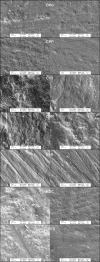Effects of 1450-ppm Fluoride-containing Toothpastes Associated with Boosters on the Enamel Remineralization and Surface Roughness after Cariogenic Challenge
- PMID: 32168543
- PMCID: PMC7069749
- DOI: 10.1055/s-0040-1705072
Effects of 1450-ppm Fluoride-containing Toothpastes Associated with Boosters on the Enamel Remineralization and Surface Roughness after Cariogenic Challenge
Abstract
Objectives: This in vitro study investigated the remineralization potential of 1450 ppm, fluoride-containing toothpastes containing different active remineralization agents after cariogenic challenge with pH cycling. The enamel surface roughness after brushing and the chemical and physical characteristics of the toothpastes tested were also analyzed.
Materials and methods: Fifty-six bovine enamel blocks were obtained (4 × 4 × 6 mm) and divided into three thirds: intact (untreated), demineralized (artificial caries lesion), and treated (caries lesion, pH cycling, and brushing with dentifrices). Seven commercially available fluoride toothpastes (1450 ppm F): three with anti-erosion claims (Candida Professional [CPP], Colgate Total 12 Daily Repair [CDR], Regenerate Enamel Science [RES]); three with desensitizing claims (Bianco Pro Clinical [BPP], Elmex Sensitive [ESS], and Regenerador Diário DentalClean [RDC]); and one standard regular-fluoride toothpaste Colgate Total 12 (CTT) were selected. During pH cycling (demineralization 6 h/remineralization 18 h) for 7 days, the treated third was brushed with the different dentifrices for 10 minutes in a brushing machine before immersion in a remineralizing solution. The Knoop hardness (25 g, 10 second of the surface, and longitudinal section were then evaluated at eight depths (10 to 330 μm). Mean and percentage of surface hardness recovery (% SHR) were calculated. Surface enamel roughness (Ra) was also evaluated. The pH, %weight of particles, zeta potential, and polydispersity index of toothpaste slurries were also evaluated.
Statistical analysis: Data were statistically analyzed (ANOVA/Tukey, 5%).
Results: The %SHR of CPP was significantly lower than the others (p < 0.05). The enamel subsurface was more effectively remineralized when treated with BPP, ESS, and RDC. The surface roughness was higher when the demineralized third was treated with CTT, RDC, and RES and after the cariogenic challenge (p < 0.05). For some of the products tested, there was no relationship between surface remineralization and subsurface remineralization. Although toothpastes CPP and RDC present the lowest %SHR means, both products effectively remineralize within the subsurface carious lesion. Regression analysis demonstrated no strong correlations of the enamel surface roughness with the chemical and physical parameters.
Conclusions: Most but not all the fluoride toothpastes were able to remineralize the enamel surface. No specific chemical or physical parameter alone correlated with the surface roughness.
Conflict of interest statement
None declared.
Figures


References
-
- Cochrane N J, Cai F, Huq N L, Burrow M F, Reynolds E C. New approaches to enhanced remineralization of tooth enamel. J Dent Res. 2010;89(11):1187–1197. - PubMed
-
- Iijima M, Moradian-Oldak J. Control of apatite crystal growth in a fluoride containing amelogenin-rich matrix. Biomaterials. 2005;26(13):1595–1603. - PubMed
Grants and funding
LinkOut - more resources
Full Text Sources

